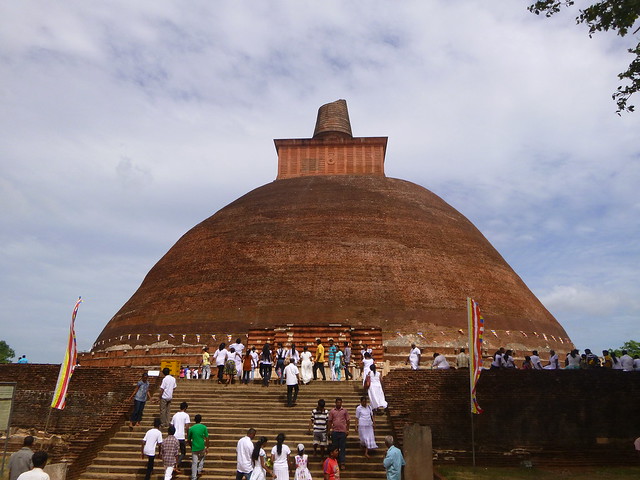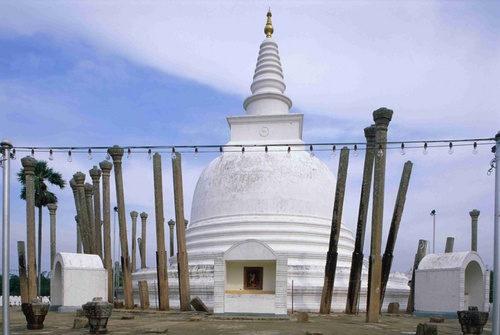Jethavanaramaya Monastery is one of the most largest monastery in the heritage city of Anuradhapura, Sri Lanka. It's original height of 122m (400ft), making it was the tallest stupa and third largest structure in the ancient world but now its remaining 71m (233ft). King Mahasena was in Anuradhapura kindom, started the construction of Jethavanaramaya Stupa and his son of King Maghavanna completed the construction. According to the history, portion of the the Buddha's sash as the relics has been deposited in this sacred stupa. Compound of the stupa covers approximately 5.6 hectares and estimated to housed approximately 10,000 buddhist monks.
Visit Nice Sri Lanka - A Wonder of Asia
Sri Lanka is a beautiful island in the Indian Ocean. A diverse and multicultural country, Sri Lanka is home to many religions, ethnic groups, and languages. Majority is Sinhalese and Buddhist. The beauty of this tiny island is simply breath-taking. Known for its enchanting ancient ruins, endless soft-sanded beaches, imposing mountains, colorful festivals, tempting water sports, dense wild-life, Sri Lanka is bound to make you come back again.
Lankathilakaya - Polonnaruwa
One of the most evocative structures in Polonnaruwa, the Lankatilaka temple was built by Parakramabahu and later restored by Vijayabahu IV. This huge gedige has 17m-high walls, although the roof has collapsed. The cathedral-like aisle leads to a huge standing (headless) Buddha. Offerings of incense, and the structure's columns and arches add to the distinctly ecclesiastical, devotional atmosphere.
Lovamahapaya - Anuradapura
Lovamahapaya was an ancient building located between Ruvanveliseya and Sri Mahabodiya in the ancient city of Anuradhapura, Sri Lanka. It is also known as the Brazen Palace or Lohaprasadaya because the roof was covered with bronze tiles.
In ancient times the building included the refectory and the uposathagara. As the roof was covered with tiles made of bronze, this was known as the Brazen Palace or Lohaprasadaya. There are 40 rows, each row consists of 40 stone pillars and a total of 1600 stone pillars were used for the building. The building was completely destroyed by a fire during the reign of King Saddhatissa.
In ancient times the building included the refectory and the uposathagara. As the roof was covered with tiles made of bronze, this was known as the Brazen Palace or Lohaprasadaya. There are 40 rows, each row consists of 40 stone pillars and a total of 1600 stone pillars were used for the building. The building was completely destroyed by a fire during the reign of King Saddhatissa.
Thuparamaya Temple - Anuradapura
This is the first stupa to be built in Sri Lanka, is believed to enshrine the collarbone Relic of the Buddha sent from India by Emperor Asoka after Anuradhapura converted to Buddhism. The Thuparama Stupa built by King Dewanampiyatissa, located in the heart of Anuradhapura.
We can imagine that there might be a colonnade which covered the stupa in a circular area which is also known as ‘Vata Dage ‘as the columns are still remaining around the Stupa. It was rewamped by the King Aggrabodhi the second who ruled around the 7th centuary.
Abhayagiri Vihara - Anuradapura
Abhayagiri Vihāra was a major monastery site of Mahayana and Theravada Buddhism that was situated in Anuradhapura, Sri Lanka. It is one of the most extensive ruins in the world and one of the most sacred Buddhist pilgrimage cities in the nation. Historically it was a great monastic centre as well as a royal capital, with magnificent monasteries rising to many stories, roofed with gilt bronze or tiles of burnt clay glazed in brilliant colors. To the north of the city, encircled by great walls and containing elaborate bathing ponds, carved balustrades and moonstones, stood "Abhayagiri", one of seventeen such religious units in Anuradhapura and the largest of its five major viharas. One of the focal points of the complex is an ancient stupa, the Abhayagiri Dagaba. Surrounding the humped dagaba, Abhayagiri Vihara was a seat of the Northern Monastery, or Uttara Vihara.
Ruwanweli Maha Seya - Anuradhapura
Ruwanwelisaya
is the one of the world tallest stupa, located in sacred city of
Anuradhapura. It was built by king Dutugamunu (140 B.C).It is standing
at 103 m (338 feet)with circumference of 290 m (950 feet)
Ruwanwelisaya is one of the 8 places of veneration in the Anuradhapura.
The Buddha's relics has been deposited in this sacred stupa.
Ruwanwalisaya is called various names such as Swarnamali Chaitya,
Mahathupa, Suvarnamali Mahaceti.
Today, after incurring much damage from invading Indian forces, it rises 55m, considerably less than its original height; nor is its form the same as the earlier ‘bubble’ shape. Its lowest circumference is usually wrapped in a strip of dazzlingly coloured cloth.
History of Anuradhapura
In 543 BC, prince Vijaya (543–505 BC) arrived in Sri Lanka, having been banished from his homeland in India. He eventually brought the island under his control and established himself as king. After this, his retinue established villages and colonies throughout the country. One of these was established by Anuradha, a minister of King Vijaya, on the banks of a stream called Kolon and was named Anuradhagama.
In 377 BC, King Pandukabhaya (437–367 BC) made it his capital and developed it into a prosperous city. Anuradhapura (Anurapura) was named after the minister who first established the village and after a grandfather of Pandukabhaya who lived there. The name was also derived from the city's establishment on the auspicious asterism called Anura. Anuradhapura was the capital of all the monarchs who ruled the country during in the Anuradhapura Kingdom, with the exception of Kashyapa I (473–491), who chose Sigiriya to be his capital. The city is also marked on Ptolemy's world map.
In 377 BC, King Pandukabhaya (437–367 BC) made it his capital and developed it into a prosperous city. Anuradhapura (Anurapura) was named after the minister who first established the village and after a grandfather of Pandukabhaya who lived there. The name was also derived from the city's establishment on the auspicious asterism called Anura. Anuradhapura was the capital of all the monarchs who ruled the country during in the Anuradhapura Kingdom, with the exception of Kashyapa I (473–491), who chose Sigiriya to be his capital. The city is also marked on Ptolemy's world map.
Subscribe to:
Comments (Atom)



